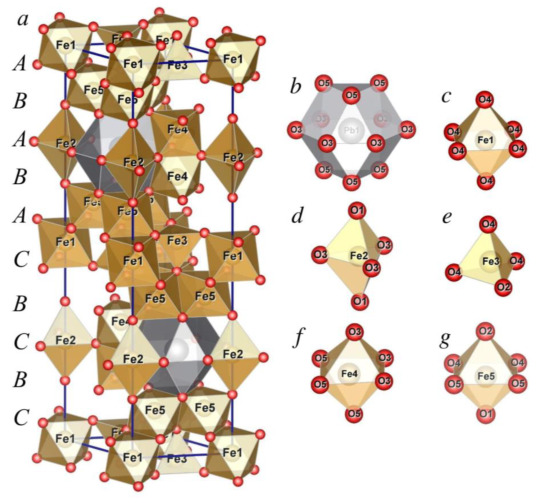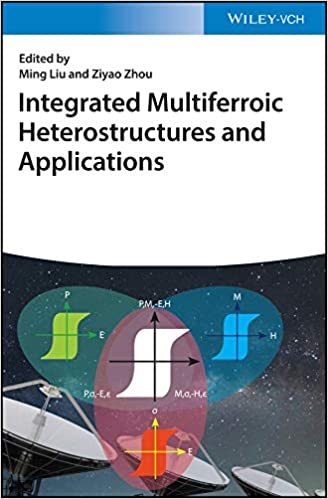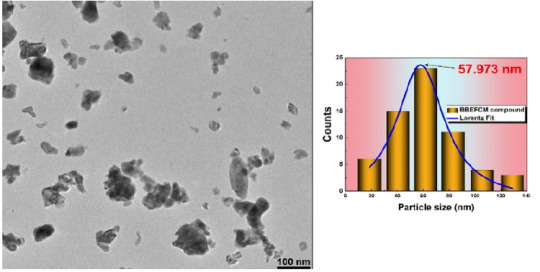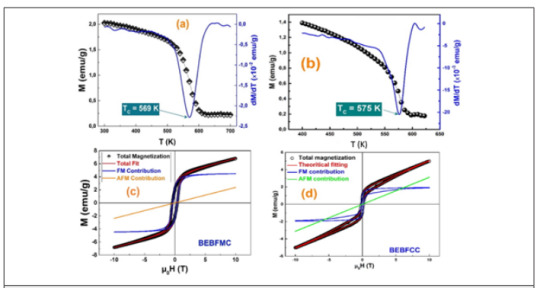#Multiferroics
Explore tagged Tumblr posts
Text

Smarter memory: Researchers introduce next-generation RAM with reduced energy consumption
Numerous memory types for computing devices have emerged in recent years, aiming to overcome the limitations imposed by traditional random access memory (RAM). Magnetoresistive RAM (MRAM) is one such memory type which offers several advantages over conventional RAM, including its non-volatility, high speed, increased storage capacity and enhanced endurance. Although remarkable improvements have been made to MRAM devices, reducing energy consumption during data writing remains a critical challenge. A study published in Advanced Science by researchers from Osaka University proposes a new technology for MRAM devices with lower-energy data writing. The proposed technology enables an electric-field-based writing scheme with reduced energy consumption compared to the present current-based approach, potentially providing an alternative to traditional RAM.
Read more.
23 notes
·
View notes
Text

Lisnevskaya, I. V., & Aleksandrova, I. A. (2020). Gel Synthesis of Hexaferrites Pb1−xLaxFe12−xZnxO19 and Properties of Multiferroic Composite Ceramics PZT–Pb1−xLaxFe12−xZnxO19. Nanomaterials, 10(9), 1630. https://doi.org/10.3390/nano10091630
#science#hexagonal ferrites#hexaferrites#chemistry#materials#materials science#crystallography#nanomaterials
35 notes
·
View notes
Text
Eleven from MIT awarded 2024 Fulbright fellowships
New Post has been published on https://sunalei.org/news/eleven-from-mit-awarded-2024-fulbright-fellowships/
Eleven from MIT awarded 2024 Fulbright fellowships

Eleven MIT undergraduates, graduate students, and alumni have won Fulbright grants to embark on projects overseas in the 2024-25 grant cycle. Two other students were offered awards but declined them to pursue other opportunities.
Funded by the U.S. Department of State, the Fulbright U.S. Student Program offers year-long opportunities for American citizen students and recent alumni to conduct independent research, pursue graduate studies, or teach English in over 140 countries.
MIT has been a Fulbright Top-Producing Institution for five years in a row. MIT students and alumni interested in applying to the Fulbright U.S. Student Program should contact Julia Mongo, MIT Fulbright program advisor, in the Office of Distinguished Fellowships in Career Advising and Professional Development.
April Cheng is a junior studying physics with a minor in mathematics and is fast-tracked to graduate this spring. They will take their Fulbright research grant to the Max Planck Institute for Gravitational Physics in Potsdam, Germany, where they will study different statistical techniques to infer the expansion rate of the universe from gravitational waves. They first developed an interest in gravitational waves and black holes at the MIT LIGO and Caltech LIGO labs, but their research spans a wide range of topics in astrophysics, including cosmology and fast radio bursts. Cheng is passionate about physics education and is heavily involved in developing educational materials for high school Science Olympiads. At MIT, they are a member of the Physics Values Committee, the physics mentorship program, and the MIT Lion Dance team. After Fulbright, Cheng will pursue a PhD in astrophysics at Princeton University, where they have received the President’s Fellowship.
Grace McMillan is a senior majoring in literature and mechanical engineering with a concentration in Russian language. As a Fulbright English Teaching Assistant Award recipient, she will teach at a university in Kazakhstan. McMillan’s interest in Central Asia was sparked by a Russian language immersion program she participated in during her sophomore summer in Bishkek, Kyrgyzstan, funded by MIT International Science and Technology Initiatives (MISTI). She is excited to help her students learn English to foster integration into the global academic community. During her time at MIT, McMillan has conducted research with faculty in nuclear science; earth, atmospheric, and planetary sciences; and the Digital Humanities Lab. Outside of academics, she has been an active member of her sorority, Sigma Kappa, and has served on the MIT Health Consumers’ Advisory Council for two years. After Fulbright, McMillan hopes to attend law school, focusing on education reform.
Ryan McTigue will graduate this spring with a BS in physics and mathematics and a concentration in Spanish. With a Fulbright award to Spain, he will do research at the University of Valencia’s Institute of Molecular Science focusing on the physics of two-dimensional multiferroic nanodevices. He is looking forward to improving his Spanish and getting the opportunity to live abroad. At MIT, McTigue became interested in condensed matter physics research with the Checkelsky group, where he focused on engineering materials with flat bands that exhibited correlated electron effects. Outside of research, McTigue has been a mentor in the physics department’s mentoring program and a member of the heavyweight men’s crew team. After his Fulbright grant, McTigue will begin a PhD in physics at Princeton University.
Keith Murray ’22 graduated from MIT with a BS in computation and cognition and linguistics and philosophy. He will receive his MEng degree in computation and cognition this spring. As a Fulbright Hungary research grantee at the HUN-REN Wigner Research Centre for Physics, Murray will design generative AI models inspired by the primary visual cortex with the goal of making AI models more interpretable. At MIT, Murray’s research experiences spanned from training mice to perform navigation tasks in virtual reality to theorizing about how neurons might compute modular arithmetic. He was also a member of the men’s heavyweight crew team and the Phi Delta Theta fraternity. After Fulbright, Murray will pursue a PhD in neuroscience at Princeton University.
Maaya Prasad ’22 completed her undergraduate education at MIT with degrees in both electrical engineering and creative writing and will graduate this month with an MS in mechanical and ocean engineering. Her thesis research focuses on microplastic detection using optical sensing. Prasad’s Fulbright fellowship will take her to Mauritius, an East African island country located in the Indian Ocean. Here, she will continue her master’s research at the University of Mauritius and will work with local researchers to implement a microplastic survey system. While at MIT, Prasad joined the varsity sailing team with no prior experience. Her time spent on the water led her to pursue marine research at MIT Sea Grant, and she eventually earned an honorable mention to the 2023 All-American Sailing Team. After Fulbright, Prasad hopes to pursue a PhD in applied ocean engineering.
Anusha Puri is a senior majoring in biological engineering. Her Fulbright award will take her to Lausanne, Switzerland, where she will conduct cancer immunology research at the Swiss Institute for Experimental Cancer Research. At MIT, Puri’s work in the Weinberg Lab focused on understanding mechanisms that drive resistance of breast cancer to immunotherapy. On campus, she founded and serves as president of MIT’s premiere stand-up comedy group, Stand-Up CoMITy, leads MIT’s Bhangra dance team, and is the editor-in-chief of the MIT Undergraduate Research Journal. She looks forward to engaging with teaching outreach and practicing her French in Switzerland. After her Fulbright grant, she plans to pursue a PhD in biomedical science.
Olivia Rosenstein will graduate this spring with a BS in physics and a minor in French. Her Fulbright will take her to ENS Paris-Saclay in Palaiseau, France, where she’ll deepen her education in atomic, molecular, and optical (AMO) physics. At MIT, Rosenstein has worked in Professor Mark Vogelsberger’s group researching models of galaxy formation and the early universe, and in Professor Richard Fletcher’s group on an erbium-lithium experiment to investigate quantum many-body dynamics in a degenerate mixture. In France, she will expand on the skills she developed in Fletcher’s lab by contributing to a project using optical tweezer arrays to study dipolar interactions. After Fulbright, Rosenstein plans to return to the United States to pursue a PhD in experimental AMO at Caltech.
Jennifer Schug will receive this spring an MEng degree in the Climate, Environment, and Sustainability track within the MIT Department of Civil and Environmental Engineering. During her Fulbright year in Italy, she will conduct research on carbon storage in the Venice lagoon at the University of Padua. Schug is excited to build upon her research with the Terrer Lab at MIT, where she is currently investigating the effectiveness of forestation as a carbon sequestration strategy. She also looks forward to improving her Italian language skills and learning about Italian history and culture. Before beginning Fulbright this fall, Schug will study ecological preservation in Sicily this summer through an MIT-Italy collaboration with the University of Catania. After Fulbright, she hopes to continue researching nature-based solutions as climate change mitigation strategies.
Vaibhavi Shah ’21 earned a BS in biological engineering and in science, technology, and society at MIT, where she was named a Goldwater Scholar. She is now a medical student at Stanford University. As a Fulbright-Fogarty Fellow in Public Health, Shah will use both her computational and humanities backgrounds to investigate sociocultural factors underlying traumatic surgical injuries in Nepal. While at MIT, she was on the executive board of GlobeMed and the Society of Women Engineers, and she hopes to use those experiences to amplify diverse voices in medicine while on her journey to becoming a neurosurgeon-scientist. After Fulbright, Shah will complete her final year of medical school.
Charvi Sharma is a senior studying computer science and molecular biology with a minor in theater arts. As a Fulbright English teaching assistant in Spain, she is excited to engage in cross-cultural exchange while furthering her skills as a teacher and as a leader. In addition to teaching, Sharma looks forward to immersing herself in the country’s vibrant traditions, improving her Spanish proficiency, and delving into the local arts and dance scene. At MIT, through Global Teaching Labs Spain and her roles as a dynaMIT mentor, an associate advisor, and a captain and president of her dance teams Mirchi and Nritya, Sharma has served as a teacher of both STEM and dance. Her passion for making a difference in her community is also evident through her work with Boston Medical Center’s Autism Program through the PKG Public Service Center and as an undergraduate cancer researcher in the Yaffe Lab. After Fulbright, Sharma plans to pursue an MD and, ultimately, a career as a clinician-scientist.
Isabella Witham is a senior majoring in biological engineering. As a recipient of the Fulbright U.S.-Korea Presidential STEM Initiative Award, she will conduct research at Seoul National University’s Biomimetic Materials and Stem Cell Engineering Lab. Her work will involve creating biomimetic scaffolds for pancreatic cell transplantation to treat type I diabetes. While in South Korea, Witham aims to improve her language skills and explore cultural sites and cities. At MIT, she worked in the Belcher Lab on nanoparticle formulations, was a tutor for MIT’s Women’s Technology Program, and volunteered as a Medlink. After her Fulbright fellowship, she plans to pursue a PhD in biological engineering.
0 notes
Photo

Scientists propose theoretical design strategy for room-temperature metal-organic multiferroics
0 notes
Link
#materials science#nanotechnology#multiferroics#oxides#memories#intel#university of california berkeley
0 notes
Photo

Nicola Spaldin
(born approximately 1970) Chemist and materials researcher
Nicola Spaldin is professor of materials theory at Eidgenössische Technische Hochschule Zürich, best known for her pioneering multidisciplinary multiferroic research predicting, describing, and creating new materials with switchable magnetic and ferroelectric properties. She is the 2015 winner of the prestigious Körber Prize among many other distinguished awards.
Number 224 in an ongoing series celebrating remarkable women in science, technology, engineering, and mathematics.
#nicola spaldin#chemistry#materials theory#women in stem#zürich#switzerland#multiferroic material#körber prize
4 notes
·
View notes
Text
A research team led by associate Prof. Yin Lihua from the Hefei Institutes of Physical Science of the Chinese Academy of Sciences has demonstrated a clear control of magnetism at low electric fields (E) at room temperature. The E-induced phase transformation and lattice distortion were found to lead to the E control of magnetism in multiferroic BiFeO3-based solid solutions near the morphotropic phase boundary (MPB). The study was published in Acta Materialia.
Multiferroic materials, with magnetic and ferroelectric properties, are promising for multifunctional memory devices. Magnetoelectric-based control methods in insulating multiferroic materials require less energy and have potential for high-speed, low-power information storage applications. BiFeO3 is a room-temperature multiferroic material with potential for use in spintronics devices, but its weak ferromagnetic and magnetoelectric effects and high voltage required for manipulation are weaknesses.
In this study, the researchers grew single crystals of the multiferroic 0.58BiFeO3-0.42Bi0.5K0.5TiO3 (BF-BKT), which lies in the tetragonal region adjacent to the MPB.
"Below the Néel temperature, TN~257.5 K, the BF-BKT crystals showed antiferromagnetic behavior," said Yin, "and at room temperature, we found that the BF-BKT crystals exhibited both short-range magnetic order and long-range ferroelectric order."
At room temperature, the multiferroic BF-BKT single crystals exhibited substantial and consistent control of magnetism with E, where the magnitude of E was significantly smaller than the ferroelectric coercive field.
In addition, high magnetic fields (H) could significantly reduce the degree of E control over magnetism.
It was found that the coupling between magnetism and ferroelectricity in the BF-BKT material can be attributed to both lattice distortion and phase transformation induced by an external E, rather than just ferroelectric domain switching. At high values of H, the converse magnetoelectric effect is weakened due to the suppression of phase transformation caused by the magnetic field.
These results suggest that designing devices based on multiferroics near the MPB could be an effective way to achieve E control of magnetism and even possible low-E switching of magnetism for low-power spintronic applications.
0 notes
Text
Integrated Multiferroic Heterostructures and Applications – eBook
Integrated Multiferroic Heterostructures and Applications – eBook PDF Penned by well-known experts in the field, this first systematic overview of multiferroic heterostructures condenses the latest developments, first presenting the fundamental mechanisms, including multiferroic materials synthesis, structures and mechanisms, before moving on to look at device applications. The resulting text,…
View On WordPress
0 notes
Text

Paving the way to extremely fast, compact computer memory
For decades, scientists have been studying a group of unusual materials called multiferroics that could be useful for a range of applications including computer memory, chemical sensors and quantum computers. In a study published in Nature, researchers from The University of Texas at Austin and the Max Planck Institute for the Structure and Dynamics of Matter (MPSD) demonstrated that the layered multiferroic material nickel iodide (NiI2) may be the best candidate yet for devices that are extremely fast and compact. Multiferroics have a special property called magnetoelectric coupling, which means that you can manipulate magnetic properties of the material with an electric field and vice versa, electric properties with magnetic fields. The researchers found NiI2 has greater magnetoelectric coupling than any known material of its kind, making it a prime candidate for technology advances.
Read more.
14 notes
·
View notes
Text
Integrated Multiferroic Heterostructures and Applications – eBook PDF
Integrated Multiferroic Heterostructures and Applications – eBook PDF
Integrated Multiferroic Heterostructures and Applications – eBook PDF Penned by well-known experts in the field, this first systematic overview of multiferroic heterostructures condenses the latest developments, first presenting the fundamental mechanisms, including multiferroic materials synthesis, structures and mechanisms, before moving on to look at device applications. The resulting text,…

View On WordPress
0 notes
Link
1 note
·
View note
Text
Physicists discover new magnetoelectric effect
0 notes
Text
Integrated Multiferroic Heterostructures and Applications – eBook PDF
Integrated Multiferroic Heterostructures and Applications – eBook PDF
Integrated Multiferroic Heterostructures and Applications – eBook PDF Penned by well-known experts in the field, this first systematic overview of multiferroic heterostructures condenses the latest developments, first presenting the fundamental mechanisms, including multiferroic materials synthesis, structures and mechanisms, before moving on to look at device applications. The resulting text,…

View On WordPress
0 notes
Text
Integrated Multiferroic Heterostructures and Applications – PDF
Integrated Multiferroic Heterostructures and Applications – PDF
Integrated Multiferroic Heterostructures and Applications – eBook PDF Penned by well-known experts in the field, this first systematic overview of multiferroic heterostructures condenses the latest developments, first presenting the fundamental mechanisms, including multiferroic materials synthesis, structures and mechanisms, before moving on to look at device applications. The resulting text,…

View On WordPress
0 notes
Text
"I AM SOME DUDE WHO WORKS IN MULTIFERROICS AND I HAVE PUBLISHED A PSEUDORELIGIOUS TURD IN A GOLD OPEN ACCESS WITH IMPACT FACTOR BELOW TWO. THIS EXPERIMENT PROPOSAL CHALLENGES YEARS OF OBSERVATION WITH LIKE 10 SIGMA CERTAINTY"
i regret to inform you that this is not #science
Babe wake up new state of matter just dropped
6K notes
·
View notes
Text
Annals of Chemical Science Research_ Crimson Publishers
Structural, Morphological and Magnetic Studies on Sol-Gel Multi-Doped BiFeO3 Compounds by Costa BFO in Annals of Chemical Science Research
Abstract
The Bi0.8Er0.1Ba0.1Fe0.96R0.02Cr0.02O3 (R = Mn3+ and Co2+) compounds were prepared by the Sol-Gel method and sintered at 800 °C for 2 hours. Both compounds present a rhombohedral structure with R3C space group. The nano-size criteria is confirmed for both compounds. The compound with Mn3+ ions presents the higher saturation magnetization and the higher amount of ferromagnetic contributions.
Keywords: Multiferroics; Sol-gel; Doped BiFeO3; Magnetization; Transmission electron microscopy
Introduction
Materials showing a simultaneous coexistence of electric and magnetic ordering have high interesting properties allowing them to be used in several application arrears especially in next-generation memory devices such as in electric fields control magnetism. These materials are known as multiferroic materials. Among these materials, bismuth ferrite with the general formula BiFeO3 (BFO) stands up, because it is one of the limited materials being simultaneously magnetic and strongly ferroelectric at room temperature [1, 2]. The pure BFO presents an anti-ferromagnetism with Neel temperature around 750K. Indeed, the weak magnetic behaviour and leakage currents are still the drawbacks for its application in the case of novel magnetoelectric effects. However, it was reported that the substitution in A or/and B-sites with suitably doped ions is deemed to be a compromising way to modulate and enhance the ferromagnetic and ferroelectric properties at room temperature of magnetic materials [3-6].
Considering the previous, the discussion of structural, morphological, magnetic and dielectric properties of BFO compound prepared by sol-gel and with the substitution of 10% of Er3+ and 10% of Ba2+ in A-site of BiFeO3 compound simultaneously with 4% of Mn3+ or Co2+ and Cr3+ (2% each one) in its B-site was done [7-9].
Results and Discussion
Structural and morphological studies
X-ray diffractograms of the Bi0.8Er0.1Ba0.1Fe0.96Co0.02Cr0.02O3 (BEBFCC) and Bi0.8Er0.1Ba0.1Fe0.96Mn0.02Cr0.02O3 (BEBFMC) compounds were indexed to bismuth ferrite material with the formula BiFeO3 (JCPDS file no. 71-2494) with rhombohedral structure, R3C space group, which confirms well the formation of the desired perovskite multiferroic material. Furthermore, minor impurity peaks are also evident in the XRD patterns of both compounds. Xpert-hight score was used to prove that these peaks correspond to the Bi2Fe4O9 and Bi25FeO40 phases. The formation of these secondary phases during the synthesis of undoped BFO and cations substituted BFO is almost unavoidable accordingly to similar studies [10,11].
The average crystallite size, estimated from XRD patterns using Scherrer formula was found to be around 68nm and 35nm in the case of BEBFCC and BEBFMC, respectively. The composition and purity of the prepared compounds were determined by energy dispersive X-ray microanalysis. The surface morphology was investigated by scanning electron microscopy and the micrographs showed that the grains are irregular and non-uniformly distributed as in the case of the pure BFO compound [7]. The particle size determination was done by transmission electron microscopy using image-J software, as shown in Figure 1 for BEBFMC. According to a Lorentzian adjustment of the particles size distribution, a value of 57nm was found. One can deduce that each particle has 2 crystallites in average. The nanosized criteria of the prepared compounds was confirmed.
Figure 1: TEM images and particles size distribution of the BEBFMC compound.

Magnetic studies
The temperature dependence of the magnetization under 0.05T of the multiferroic BEBFMC and BEBFCC are shown in Figure 2. One can notice that the magnetization of the BEBFMC compound is higher than that of BEBFCC. Clearly, the magnetization of both compounds, rises when decreasing temperature and shows an inflection point at around 569K and 575K for BEBFMC and BEBFCC, respectively. This temperature is attributed to the Ferromagnetic-Paramagnetic phase transition known as the Curie Weis (TC) temperature. It is important to mention that the TC temperature of the pure BiFeO3 compound was found to be higher than 750K [12], so the utility of the substitution in both A and B sites was confirmed to decrease the TC temperature , especially in the case of Mn ions. The room temperature hysteresis (M(H)) loops of the BEBFMC and BEBFCC compounds are shown in Figure 2, respectively. As one can see, in both compounds, the magnetization occurs in two different behaviours; first region where the magnetization increases very sharply with increasing magnetic field, while at high magnetic fields the magnetization is more-or-less saturated and exhibits a linear behaviour. For pure BFO, the M-H curves exhibit an almost unsaturated straight line which proves that it has a G-type Antiferromagnetic (AFM) with canting of Fe3+ ions [13]. Both behaviours at high and low magnetic fields, confirm the existence of a competition between ferromagnetic (FM) and antiferromagnetic (AFM) interactions due to the substitution in A and B-sites of the BFO compound. This magnetic competition enhances the total magnetization in the studied compound. The saturated magnetization MS of the BEBFMC and BEBFCC compounds were found to be around 6.8 and 5.5emu/g, respectively, at room temperature which is more than seventeen times larger than that of the pure BFO compound (about 0.3 emu/g) [14,15]. This enhancement of magnetization is due essentially due to the FM interactions occurring with the substitutions of both A and B-sites.
The M-H loops have been modulated to quantify theoretically the FM and the AFM contributions, using the following equation:

where MFMS, MFMR, Hci are the ferromagnetic saturation magnetization, remnant magnetization, intrinsic coercive field, respectively. The first term in this equation is ascribed to the irreversible component of magnetization, coming from the ferromagnetic contribution (FM). The second one is due to the antiferromagnetic contribution (AFM) and shows a linear behaviour with the applied magnetic field [16,17]. The simulated ferromagnetic and antiferromagnetic contributions at room temperature for both compounds are shown in Figure 2. The resulted fitting parameters are listed in Table 1. From the fitted parameters values, it is concluded that for BEBFMC compound, the AFM contributions are around 34.48% of the total magnetization, while the FM part presents 65.62%, which confirms the domination of the FM contribution over the AFM one. As conclusion, the enhancement of the magnetization in BEBFMC is due especially to the ferromagnetic contribution originated from the substitutions in A and B-sites, while for BEBFCC compound, the AFM contribution dominates the total magnetization (61.3 %) over the FM.
Figure 2: (a) and (b) Magnetization vs. temperature and its first derivation of the BEBFMC and BEBFCC compounds, respectively. (c) and (d) Fit results of the Hysteresis loop at room temperature of the BEBFMC and BEBFCC compounds, respectively.

Table 1:Parameters extracted from fitting the magnetization hysteresis loops of the compounds.

Conclusion
The utility of multi doping the BiFeO3 system was confirmed. When introducing a low concentration of Erbium and Barium in A-site with a low amount of Chromium and (Manganese or Cobalt) in B-site, the total magnetization rises more than seventeen times compared to undoped BiFeO3 compound. The Mn3+ ions in B-site enhances the amount of the FM contribution in the compound leading to a rise in magnetization.
#crimson publishers#Annals of Chemical Science Research#Chemistry open access journals#peer reviewed journal of ACSR
0 notes